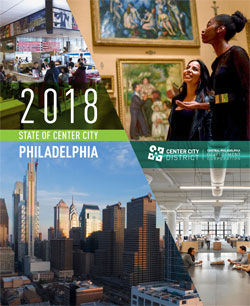
| Share: Facebook | Twitter | LinkedIn |
The Central Philadelphia Development Corporation (CPDC)/Center City District (CCD) has released State of Center City 2018, a 75-page report which distills a wealth of up-to-the-minute data from city, state and national agencies; a broad range of local organizations and businesses; and Center City District’s own in-depth data analysis to examine Philadelphia’s current successes and challenges, benchmark our strengths and weaknesses against other metropolitan areas; candidly highlight our shortcomings; and make policy recommendations to address those deficiencies.
Philadelphia is enjoying the longest period of economic expansion in the last 50 years, adding 55,100 jobs since 2010 and showing positive growth in all but one year since 2005. Philadelphia added a record 13,600 jobs in 2016, tapering down to 10,700 more jobs in 2017. For a city that has been contracting since the 1950s, this is positive news. Center City is the largest employment hub in the city and region, holding 42% of Philadelphia’s jobs with 298,612 wage and salaried positions and another 9,000 self-employed individuals, freelancers and those compensated as partners. Other growth areas include University City, with 11% of city jobs, and the fast growing Navy Yard, with 1% of the city’s jobs. But by national, urban standards, things should be significantly better. While private sector growth was particularly strong in 2016 and 2017, with the city’s rate surpassing that of the region and nearly catching up with the nation as a whole, Philadelphia has not kept pace with the rate of employment growth in America’s 26 largest cities. Since 2005, the balance of Philadelphia has continued to lose jobs at the rate of 0.4% per year. This year's report presents a downtown with many positives, but simply not enough to offset declines elsewhere. Despite success in Center City, 62,000 more residents of city neighborhoods since 2010 decamped for homes in the suburbs than moved in and Philadelphia's 25.7% poverty rate is the highest of the 10 largest U.S. cities. What can be done? Along with an exhaustive look at factors shaping the city's current situation, State of Center City 2018 also makes recommendations toward policy reforms that could help Philadelphia capitalize on recent positive trends and realize its full potential. To download the report in full, or by chapter, visit CenterCityPhila.org/socc/. For a full selection of Center City District reports, visit CenterCityPhila.org/research-reports. If you would like to sign up for email updates about future CCD publications, click here. |
